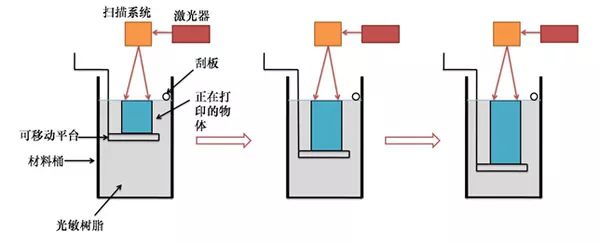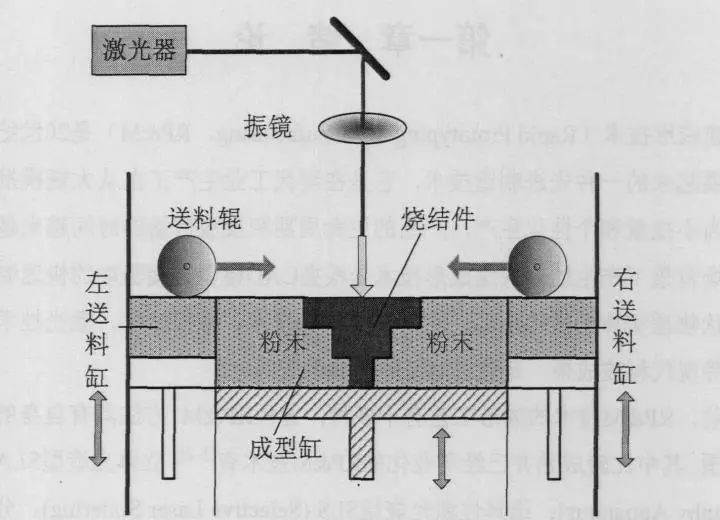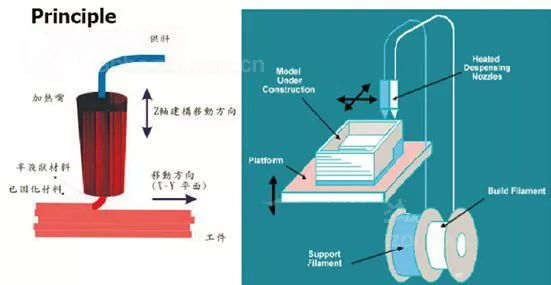Author: Mao Fulii, Source: Sensor Technology

Text | Sensor Technology
If you were to choose a technology that could change the world today, what would it be? Artificial intelligence, blockchain, AR and VR technology, or the quietly transformative 3D printing technology? Compared to the previously mentioned hot scientific advancements, 3D printing seems to flash like a meteor, shining brightly for a moment before disappearing. In reality, 3D printing technology is changing the world at an even faster pace.

The 3D printer is a magical device designed by an inventor named Enrico Dini. It can not only “print” a complete building but can also print any required objects for astronauts aboard a spacecraft.
A 3D printer is a machine that uses rapid prototyping technology. It constructs objects based on digital model files, utilizing special wax materials, powdered metals, or plastics through a layer-by-layer printing method. It is often used in mold manufacturing and industrial design to create models or directly manufacture some products, indicating that this technology is becoming widespread.

The Technical Principle of 3D Printing
3D printing is not a new technology; the concept originated in the late 19th century in the United States and was developed and popularized in the 1980s. The China Internet of Things School-Enterprise Alliance refers to it as “the thought of the last century, the technology of the last century, and the market of this century.” 3D printing typically employs digital technology materials to achieve printing. The output and sales of these printers have significantly increased since the 21st century, and their prices are decreasing year by year.
Using a printer is like printing a letter: you click the “print” button on your computer screen, and a digital file is sent to an inkjet printer, which sprays a layer of ink onto the paper’s surface to create a two-dimensional image. In 3D printing, software employs computer-aided design (CAD) technology to complete a series of digital slices, transmitting this slice information to the 3D printer, which stacks continuous thin layers until a solid object is formed. The biggest difference between a 3D printer and a traditional printer is that the “ink” used is actual raw material.

There are various forms of stacking thin layers. Some 3D printers use an “inkjet” method. For example, an Israeli company called Objet uses printer nozzles to spray an extremely thin layer of liquid plastic onto a mold tray, which is then treated under ultraviolet light. The mold tray then descends a tiny distance for the next layer to stack on. Another company based in Minneapolis, Stratasys, employs a technique called “fused deposition modeling,” where plastic is melted inside the nozzle, and then deposited in layers to form the object.
Some systems use powdered particles as the printing medium. Powdered particles are sprinkled onto the mold tray to form a very thin layer, which is then solidified by a sprayed liquid adhesive. It can also use a technique called “laser sintering” to fuse into the desired shape, a method used by the German company EOS in its additive manufacturing machines. The Swiss company Arcam uses electron beams in a vacuum to melt powdered particles.
The methods mentioned above are just a few of the many forming techniques. When faced with complex structures that include holes and cantilevers, gel or other materials need to be added to provide support or fill space. This part of the powder will not be fused, and can be washed away with water or air flow to create voids. Today, a variety of materials can be printed, from numerous plastics to metals, ceramics, and rubber. Some printers can even combine different materials, allowing for objects that are hard on one end and soft on the other.
The Development History of 3D Printing Technology
3D printing originated from photogrammetry and terrain forming techniques researched in the United States over a century ago, with prototypes appearing in the 1980s under the name “rapid prototyping.”
In the mid-1980s, SLS was developed and patented by Dr. Carl Deckard at the University of Texas at Austin, sponsored by DARPA. In 1979, a similar process was patented by RF Housholder but was not commercialized.
In 1995, MIT coined the term “three-dimensional printing,” when graduates Jim Bredt and Tim Anderson modified the inkjet printer design to squeeze a binding solvent onto a powder bed instead of ink onto paper.
Speaking of 3D printing, we must mention 3D printers. 3D printers, also known as three-dimensional printers, are an additive manufacturing technology that builds three-dimensional objects by printing layers of adhesive material. Currently, 3D printers are used to manufacture products. Since 2003, the sales of 3D printers have gradually expanded, and prices have begun to decrease.
This technology can be applied in jewelry, footwear, industrial design, architecture, engineering and construction (AEC), automotive, aerospace, dentistry, medical industry, education, geographic information systems, civil engineering, and many other fields.
The core manufacturing idea of 3D printing originated in the late 19th century in the United States, and by the late 1980s, 3D printing technology had matured and been widely applied. 3D printing represents one of the latest high-dimensional manifestations in the integration of technology.
Currently, the usage of 3D printers is still quite limited, but one day in the future, people may be able to print more practical items through 3D printers.
What Can 3D Printing Do?
Printing Clothing
As early as 2013, Victoria’s Secret fashion show showcased clothing made with 3D printing technology, where supermodel Lindsay Ellingson dazzled in a pair of wings, a corset, and a headpiece printed by a 3D printer, which still astonishes people today.
Printing Prosthetics
In 2012, a boy in Sudan lost both hands due to injuries during a standoff between two armies. This incident came to the attention of Mick Ebeling, who established a lab in Sudan equipped with a 3D printer to help amputees print their most suitable prosthetics using 3D printing technology.

In 2016, a 3D printing technology company in Hunan developed technology to print human bones, which is now officially applied. Recently, Yonsei University in South Korea announced that they have developed a commercially viable 3D printed artificial eye that is almost indistinguishable from a real one, indicating that we may no longer see any physically disabled people on the streets in the future.
Printing Anything You Want
In fact, at this point, almost all common items in life can be manufactured using 3D printing technology. For example, cars can already be produced using 3D printing technology; currently, major engine manufacturers are even trying to use 3D printing technology to create car engines. For instance, a construction company in Shanghai previously showcased a house made using a 3D printer. While it may not look very appealing, the cost is extremely low—under fifty thousand yuan, you could have your own small apartment, provided you own the land. In addition to houses and cars, 3D printing can also produce candies—edible candies without any concerns, and even artworks, firearms, etc.

Types of 3D Printing Technology
SLA (Stereolithography Appearance)
This method focuses a laser of specific wavelength and intensity onto the surface of photopolymer materials, solidifying it sequentially from points to lines to surfaces, completing a layer’s drawing task, after which the platform moves vertically by one layer height to solidify another layer. This layer-by-layer stacking forms a three-dimensional entity.
SLA is the earliest practical rapid prototyping technology, using liquid photopolymer resin as raw material. Its working principle involves placing liquid photopolymer resin in a processing tank, where initially the height of the work platform differs from the liquid surface by one layer thickness. A focused laser scans the surface of the photopolymer resin according to the cross-sectional profile, and the scanned resin gradually solidifies, producing a solid resin part that matches the cross-sectional profile. At this point, the work platform lowers by one layer height, and the solidified resin part is submerged in the liquid photopolymer resin surrounding it that has not been irradiated by the laser. The laser then begins scanning according to the next layer’s cross-sectional profile, with the newly solidified resin adhering to the layer below, and this process continues until the entire part is processed. The completed part is then polished, electroplated, painted, or colored to obtain the desired product.

Advantages:
1. The photopolymerization method is the earliest rapid prototyping process, with a high level of maturity;
2. Directly produces prototypes from CAD digital models, with fast processing speed, short production cycles, and no need for cutting tools or molds;
3. Capable of processing prototypes and molds with complex structures that are difficult to form using traditional methods;
4. Visualizes CAD digital models, reducing the cost of error correction;
5. Provides samples for experiments, allowing for verification and validation of computer simulation results;
6. Can be operated online, remotely controlled, facilitating automation in production;
Disadvantages:
1. SLA systems are expensive, with high usage and maintenance costs;
2. SLA systems operate on liquid materials and require a stringent working environment;
3. The formed parts are mostly resin-based, with limited strength, rigidity, and heat resistance, making long-term preservation difficult;
4. The software system is complex to operate, with a steep learning curve; the file formats used are not familiar to most designers;
5. The resin shrinks during the curing process, inevitably producing stress or deformation;
SLS (Selective Laser Sintering)
Selective laser sintering uses a laser to selectively sinter solid powder layer by layer, forming the desired shape through the accumulation of solidified layers. The entire process includes CAD model establishment and data processing, powder spreading, sintering, and post-processing.
The entire system consists of a powder cylinder and a forming cylinder. During operation, the powder cylinder piston (feeding piston) rises, and the powder roller evenly spreads a layer of powder onto the forming cylinder piston (working piston). The computer controls the two-dimensional scanning trajectory of the laser beam based on the sliced model of the prototype, selectively sintering solid powder materials to form one layer of the part. After completing one layer, the working piston lowers by one layer thickness, and the powder system spreads new powder. The laser beam is then controlled to scan and sinter the new layer. This cycle continues until the three-dimensional part is formed. Finally, the unsintered powder is returned to the powder cylinder, and the formed part is removed. For metal powder laser sintering, the entire working platform is heated to a specific temperature before sintering to reduce thermal deformation during forming and facilitate the bonding between layers.

Advantages:
1. SLS uses a wide range of forming materials. Currently, materials that can be processed by SLS include wax, polymers, metals, ceramic powders, and their composite powders, with performance suitable for various applications.
2. SLS does not require the design and manufacture of complex support systems.
Disadvantages:
After processing, SLS-formed parts tend to have rough surfaces, and the post-processing techniques to enhance mechanical properties are also relatively complex. (Roughness depends on the diameter of the powder.)
LOM (Laminated Object Manufacturing)
This method uses sheets (such as paper, plastic film, or composite materials) as raw materials. A laser cutting system cuts the inner and outer contours of the workpiece from paper coated with hot melt adhesive according to the cross-sectional profile data extracted by the computer. After cutting one layer, a new layer of paper is added, and a hot press device bonds the cut layers together before proceeding to the next cut. This layer-by-layer cutting and bonding ultimately forms a three-dimensional workpiece. Common materials for LOM include paper, metal foil, plastic film, and ceramic film. This method can be used not only to manufacture molds and models but also to directly create structural or functional parts.

Advantages:
1. Reliable operation, good model support, low cost, and high efficiency. The downside is that pre- and post-processing can be time-consuming and labor-intensive, and it cannot produce hollow structures.
2. Forming materials: fiber paper coated with thermosensitive adhesive;
3. Performance of the produced parts: comparable to high-grade wood;
4. Main uses: rapid manufacturing of new product samples, models, or wooden molds for casting.
FDM (Fused Deposition Modeling)
This method uses filamentous materials (such as wax, metal, plastic, or low-melting-point alloy wire) as raw materials, heating the filament to just above its melting point (about 1°C higher than the melting point) using electric heating. Under computer control, the nozzle moves in the x-y plane, applying the molten material onto the worktable, which cools to form a layer of the part’s cross-section. After one layer is formed, the nozzle rises by one layer height to apply the next layer (some literature states that the worktable descends by one layer height, and then the nozzle prints the next cross-section). This process continues, with the thermoplastic filament being layered on the worktable to complete the required cross-sectional profile until finished.
The FDM process can utilize various materials, including polycarbonate, engineering plastics, and their blends.
This process does not use lasers, is simple to use and maintain, and has a low cost. Prototypes made from ABS are widely used in product design, testing, and evaluation due to their high strength. Recently, higher-strength forming materials such as PC, PC/ABS, and PPSF have been developed, allowing this process to directly manufacture functional parts. Due to its notable advantages, this process has developed rapidly, and FDM systems currently hold the largest share of the rapid prototyping systems installed worldwide.

Advantages:
1. This technology has low pollution, and materials can be recycled, suitable for forming medium and small parts;
2. Forming materials: solid filamentous engineering plastics;
3. It is possible to use water-soluble support materials to facilitate separation from the workpiece, allowing for the processing of bottle-shaped or other hollow parts;
4. Performance of the produced parts: comparable to engineering plastics or wax molds;
5. Main uses: plastic parts, wax molds for casting, samples, or models.
Disadvantages:
1. Lower processing precision compared to SLA technology;
2. The surface of the parts is relatively rough;
3. The processing time is relatively long.
3DP Technology
3DP, or 3D printing, employs standard inkjet printing technology to create three-dimensional solid models by layer-by-layer depositing a liquid binder onto a powder layer, printing cross-sectional data. The samples produced using this technology have the same colors as the final products, and color analysis results can be directly depicted on the models, conveying significant information; it is currently the most mature color 3D printing technology.

Existing Problems and Solutions of 3D Printing Technology
Material Limitations
Currently, mainstream 3D printing technologies can achieve printing with polymer plastics, certain metals, or ceramics, but there are still many materials that cannot be printed. Material limitations mainly manifest in two aspects: on one hand, the types of materials that current 3D printing technologies can print are limited, unable to fully meet the diverse material requirements in industrial production. This makes 3D printing technology applicable only in specific situations, with significant barriers to widespread adoption. On the other hand, for specific 3D printers, the types of printable materials are even more limited, necessitating the design of dedicated 3D printers for each type or category of material, resulting in less universality compared to traditional machining. Although progress has been made in multi-material printing, unless these advancements reach maturity and effectiveness, material will remain a significant obstacle for 3D printing.
Solutions:
To address these two issues, the following approaches can be considered: 1. Develop new materials, which is a direction actively pursued by the country. By developing new printing materials with good performance that can meet traditional material requirements, the universality of 3D printing technology can be improved. 2. Enhance the versatility of 3D printers themselves. This can be approached from a modular design perspective, maintaining consistent structural integrity while only changing certain components, such as nozzles, for different types or categories of materials, ensuring easy interchangeability.
Low Printing Efficiency
Low efficiency can be analyzed from two perspectives. First, compared to traditional machining, which removes material from a blank to create parts, the difference in material between the blank and the part is usually minimal, requiring less material to be removed, resulting in faster processing. In contrast, 3D printing technology must stack all the material required for the solid parts through an additive method, resulting in a larger material volume. Thus, when comparing the volume of material removed versus added, the additive volume is typically larger than the subtractive volume. Second, considering the forming motion, traditional machining primarily involves rotational movements, while 3D printing technology relies on linear movements, which are less capable of achieving high speeds and maintaining stability. Consequently, 3D printing technology not only requires a larger volume of material for processing but is also limited in motion speed, leading to overall lower processing efficiency.
Solutions:
For the first issue, consider adding material to a predefined blank to reduce the amount of material that needs to be printed, particularly in mass production scenarios, by pre-designing a series of solid profiles containing the minimum blank material required. For the second issue, design mechanisms capable of high-speed movement, such as parallel mechanisms. Additionally, coordinating material design to increase melting or solidification speeds is necessary. Software and trajectory planning can also be improved by adopting gradient design concepts, where higher fill rates are selected for areas with strength requirements, while lower fill rates are used for other areas, rather than applying the same fill rate across the entire solid.
Low Quality and Precision
Firstly, regarding quality, due to the additive manufacturing process of “layered manufacturing, stacking layers,” no matter how tightly the layers bond, they cannot compare to parts cast as a whole using traditional molds. The microscopic structure and organization of the materials determine the physical properties of the parts, such as strength, rigidity, wear resistance, fatigue resistance, and gas tightness, which often do not meet engineering requirements. Secondly, regarding precision, the inherent forming principles and the development of 3D printing technology are still incomplete, resulting in lower precision for printed parts, including dimensional accuracy, shape accuracy, and surface roughness. As a result, they cannot be used as functional parts and are limited to prototype usage, significantly reducing their applicability.
Solutions:
To address quality issues, consider aligning the print texture with the primary stress direction of the part to increase strength and prevent tearing or damage under load. For precision issues, research high-resolution printing technologies to reduce layer resolution while considering the matching of printing efficiency. Additionally, combining additive and subtractive technologies can enhance surface treatment or other post-processing.




